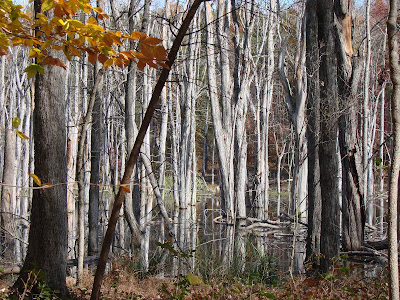

Tonight at the Guilford County Commissioner’s meeting the commissioners approved the purchase of the 250 acre Richardson tract off of Plainfield Rd. near Church St. for $2.56 million. (Click to enlarge map above.) The broadly supported decision by the commissioners, after one and a half years of hard work by the Guilford County Open Space Committee, ensures completion of our goal to preserve 443 acres of beautiful uplands and very sensitive wetlands that flow directly into Lake Townsend. This major project will protect and improve our water quality and our air quality. This project will provide significant protection for trees, plants, waterfowl and animals. This project helps to sooth the eye and the soul.
The State Of NC agreed on Nov. 4th to purchase the adjoining 193 acre Morton tract. The two tracts combine to preserve 443 acres. The state became very interested because the joint purchase of the two tracts provides most of the route for the Mountains to Sea Trail from the Greensboro Watershed Trials to the Haw River State Park. The Richardson family of Vicks Vaporub fame and the Morton family of Grandfather Mountain fame also gifted a significant part of their property for this major conservation project. To make this deal potentially sweeter the Open Space Committee will apply for a grant of around $1.3 million from NC Clean Water Management Trust Fund.
It was the Guilford County Open Space Committee that conceived and nominated the Haw River State Park in 2001 that now contains around 1500 acres and is growing. In 2006 and 2007 two additional tracts were purchased and preserved by the Open Space Committee and in 2008 we preserved seven new tracts. Not counting our important efforts at the Haw River State Park (that used only state funds) we have now preserved nine tracts of open space in Guilford County that total 725.5 acres. Of the $10 million Open Space Bond Funds approved in 2004 we have now spent (including the Richardson tract) $3.8 million. Over $6 million in funding still remains for additional projects in Guilford County. (Wake County voters overwhelmingly passed an additional $50 million open space bond in 2007 and in Mecklenburg County voters approved an additional $34 million.)
The State Of NC agreed on Nov. 4th to purchase the adjoining 193 acre Morton tract. The two tracts combine to preserve 443 acres. The state became very interested because the joint purchase of the two tracts provides most of the route for the Mountains to Sea Trail from the Greensboro Watershed Trials to the Haw River State Park. The Richardson family of Vicks Vaporub fame and the Morton family of Grandfather Mountain fame also gifted a significant part of their property for this major conservation project. To make this deal potentially sweeter the Open Space Committee will apply for a grant of around $1.3 million from NC Clean Water Management Trust Fund.
It was the Guilford County Open Space Committee that conceived and nominated the Haw River State Park in 2001 that now contains around 1500 acres and is growing. In 2006 and 2007 two additional tracts were purchased and preserved by the Open Space Committee and in 2008 we preserved seven new tracts. Not counting our important efforts at the Haw River State Park (that used only state funds) we have now preserved nine tracts of open space in Guilford County that total 725.5 acres. Of the $10 million Open Space Bond Funds approved in 2004 we have now spent (including the Richardson tract) $3.8 million. Over $6 million in funding still remains for additional projects in Guilford County. (Wake County voters overwhelmingly passed an additional $50 million open space bond in 2007 and in Mecklenburg County voters approved an additional $34 million.)












































